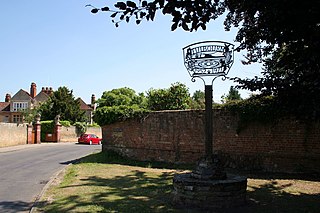The Lord High Chancellor of Ireland was the highest judicial office in Ireland until the establishment of the Irish Free State in 1922. From 1721 to 1801, it was also the highest political office of the Irish Parliament: the Chancellor was Speaker of the Irish House of Lords. The Lord Chancellor was also Lord Keeper of the Great Seal of Ireland. In all three respects, the office mirrored the Lord High Chancellor of Great Britain.

The Dean of St Patrick's Cathedral is the senior cleric of the Protestant St Patrick's Cathedral, Dublin, elected by the chapter of the cathedral. The office was created in 1219 or 1220, by one of several charters granted to the cathedral by Archbishop Henry de Loundres between 1218 and 1220.
The Robert Luttrell who settled on the banks of the Liffey near Dublin at Luttrellstown, was in 1226 made treasurer of St. Patrick's Cathedral and Archdeacon of Armagh, and in 1236 was appointedLord Chancellor of Ireland which office he held until 1245.
Fromund le Brun was a cleric and judge in thirteenth-century Ireland who became Lord Chancellor of Ireland. He lost a long battle to become Archbishop of Dublin, due largely to his notorious pluralism. He also clashed bitterly with the formidable Archbishop of Cashel, David Mac Cerbaill, who excommunicated him.

Alexander de Balscot, also known as Alexander Petit was one of the leading Irish clerics of the late fourteenth century, who held the offices of Bishop of Ossory, Bishop of Meath, Treasurer of Ireland and Lord Chancellor of Ireland.
Thomas Cranley DD a.k.a. Thomas Craule was a leading statesman, judge and cleric in early fifteenth-century Ireland, who held the offices of Chancellor of Oxford University, Archbishop of Dublin and Lord Chancellor of Ireland.
Sir Laurence Merbury was an English-born statesman in Ireland who held the office of Treasurer of Ireland and was also Deputy to the Lord Chancellor of Ireland.
Roger Utlagh, or Roger Outlawe was a leading Irish cleric, judge and statesman of the fourteenth century who was Prior of Kilmainham, and held the office of Lord Chancellor of Ireland. He was the brother-in-law of the celebrated Witch of Kilkenny, Alice Kyteler, and is mainly remembered today for his efforts to shield her from prosecution, and subsequently enabling her to escape punishment, during the Kilkenny Witch Trials of 1324.

Walter de Fulburn, or de Fulbourn was a leading English-born statesman and cleric in medieval Ireland, who held the offices of Bishop of Waterford, Bishop of Meath and Lord Chancellor of Ireland
John L'Archers, Larger or L'Archer was an English-born cleric and judge who had a distinguished career in Ireland, holding the offices of Lord Chancellor of Ireland and Deputy Justiciar. He died during the first outbreak of the Black Death in Europe and was probably a victim of it.
Richard de Beresford or Bereford was an English-born cleric and judge who held high political office in Ireland in the early fourteenth century as Lord High Treasurer of Ireland and Lord Chancellor of Ireland.
Walter de Islip, or de Istlep was an English-born cleric, statesman, and judge in fourteenth-century Ireland. He was the first Chief Baron of the Irish Exchequer; he also held the offices of Treasurer of Ireland, Chief Escheator, and Custos Rotulorum of Kilkenny. He was a noted pluralist, who held numerous clerical benefices. His career was damaged by accusations of corruption and maladministration. He played an important role in the celebrated Kilkenny Witchcraft Trials of 1324.
Nicholas de Balscote was an English-born official and judge in fourteenth-century Ireland. He attained high judicial office, but his career was damaged by a quarrel with King Edward II.
Robert Sutton was an Irish judge and Crown official. During a career which lasted almost 60 years he served the English Crown in a variety of offices, notably as Deputy to the Lord Chancellor of Ireland, Chief Baron of the Irish Exchequer, Master of the Rolls in Ireland, and Deputy Treasurer of Ireland. A warrant dated 1423 praised him for his "long and laudable" service to the Crown.
Thomas Minot, also spelt Mynot or Mynyot was an English-born judge and cleric in fourteenth-century Ireland. He was Archbishop of Dublin from 1363 to 1375. He is chiefly remembered for his extensive restoration works to St Patrick's Cathedral, Dublin, and in particular for rebuilding the Cathedral's tower, which is still called Minot's Tower.
Robert le Poer was an Irish judge and Crown official who held the offices of Lord High Treasurer of Ireland and Chief Baron of the Irish Exchequer.
William de Karlell was an English-born judge, administrator and cleric in fourteenth-century Ireland. He held numerous benefices including Archdeacon of Meath and Rector of Youghal, and sat in the Irish House of Commons. After sitting for some years as a Baron of the Court of Exchequer (Ireland) he was removed from office, following a flood of complaints about his acts of extortion and oppression committed by himself and Chief Baron Holywood, but he was later restored to favour, and served briefly as Chief Baron of the Irish Exchequer. He is buried in St Canice's Cathedral, Kilkenny.
William Chevir, or Chevyr was an Irish politician and judge, whose career was marked by accusations of oppression and corruption.
Robert Preston, 1st Baron Gormanston was an Anglo-Irish nobleman, statesman and judge of the fourteenth century. He held several senior judicial offices including, for a brief period, that of Lord Chancellor of Ireland. He was the founder of the leading Anglo-Irish Preston family whose titles included Viscount Gormanston and Viscount Tara.

Robert de Shardlow, or de Shardelaw (1200-c.1260) was a senior Crown official, diplomat and judge who had a distinguished career in both England and Ireland in the reign of King Henry III of England. He also became a substantial landowner in both countries.




